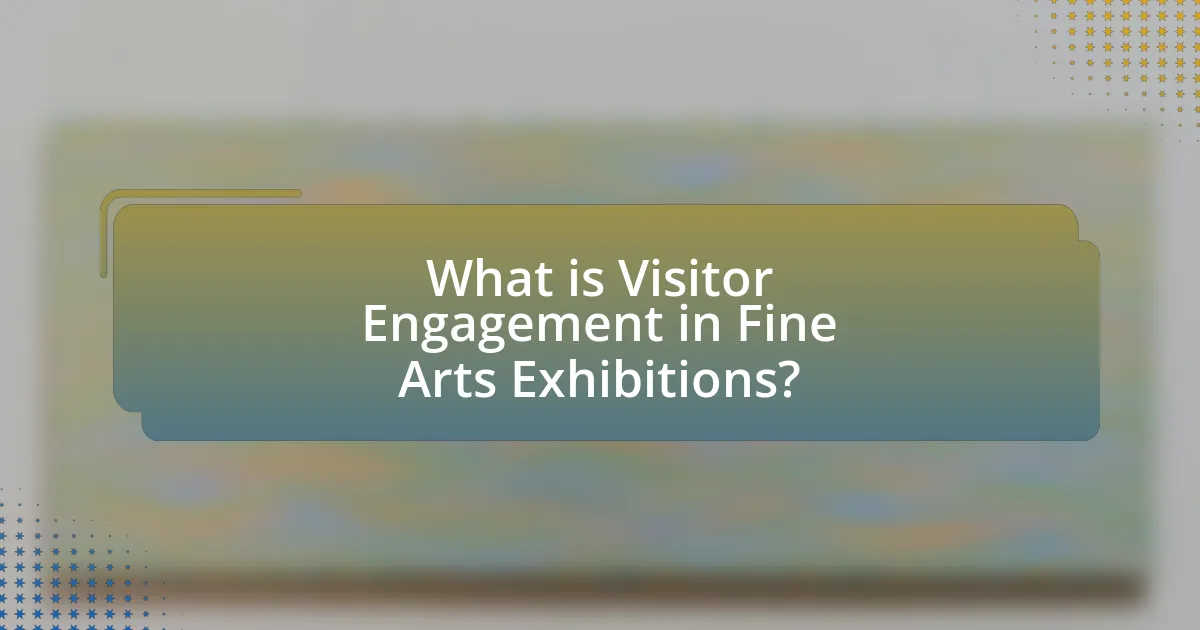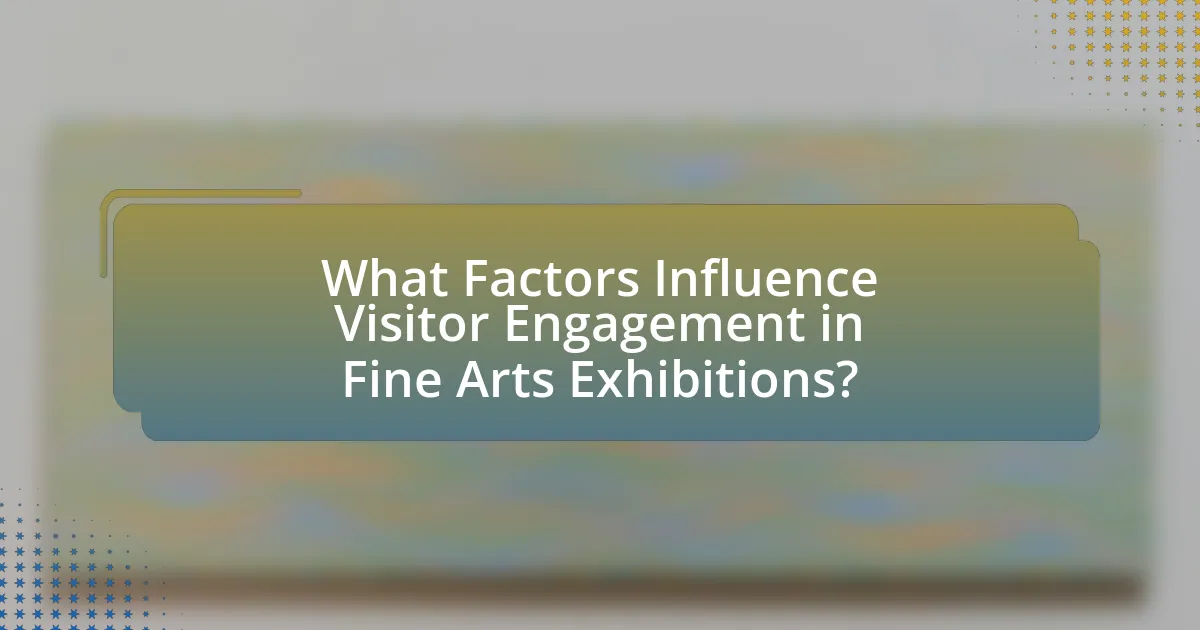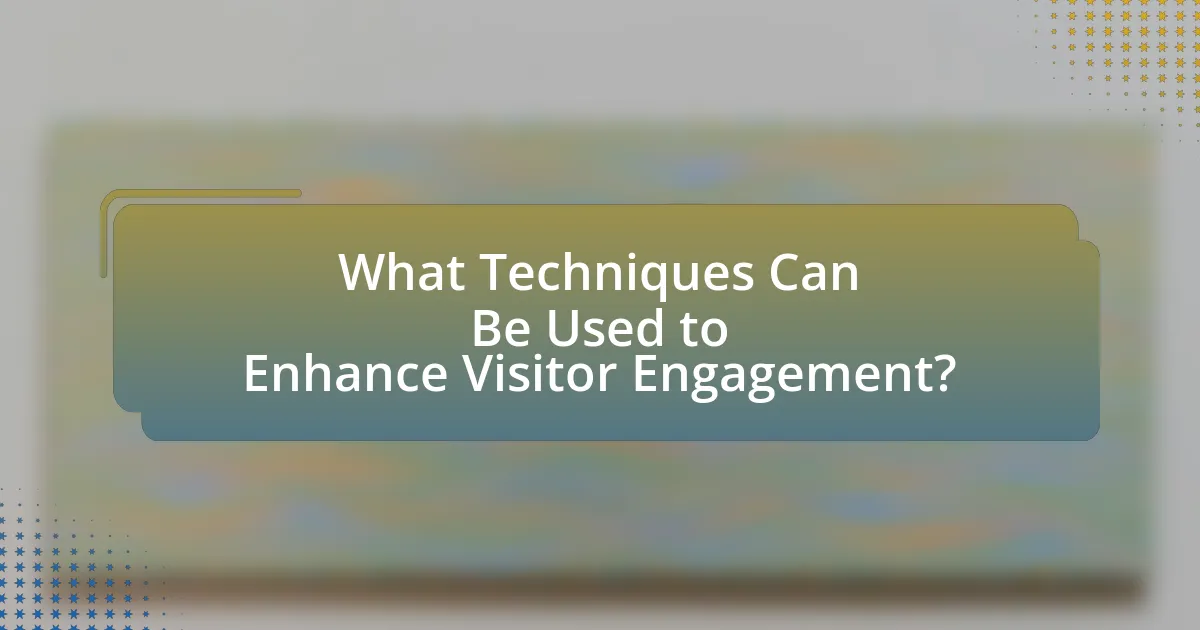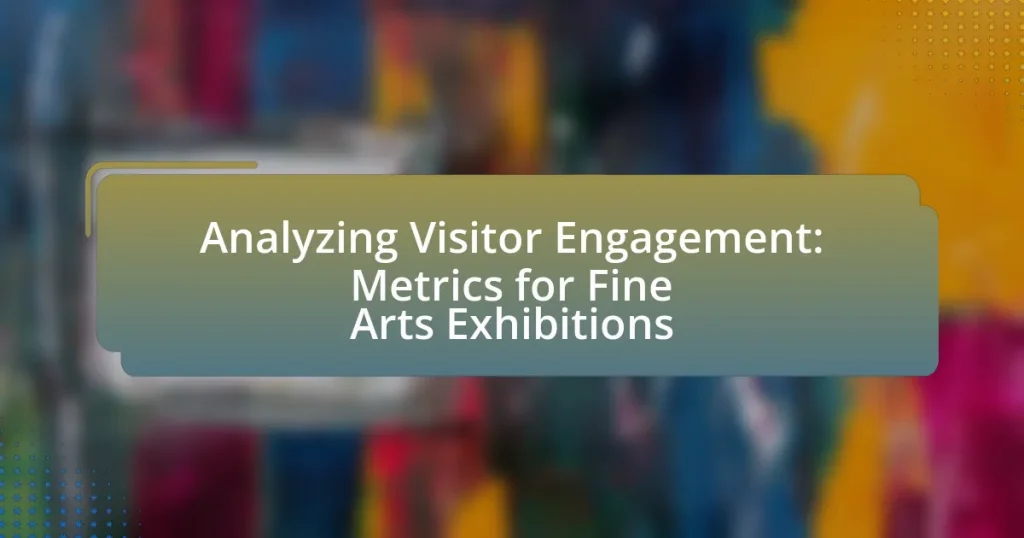Visitor engagement in fine arts exhibitions encompasses the interactions and involvement of attendees with artworks and the exhibition environment, measured through metrics such as attendance, dwell time, and visitor feedback. This article analyzes the significance of visitor engagement, highlighting key metrics used to assess it, including qualitative and quantitative measures, and the impact of factors like exhibition design, accessibility, and technology. Additionally, it explores strategies to enhance engagement, the role of community involvement, and the challenges organizations face in measuring engagement effectively. Understanding these elements is crucial for improving visitor satisfaction and driving the success of fine arts exhibitions.

What is Visitor Engagement in Fine Arts Exhibitions?
Visitor engagement in fine arts exhibitions refers to the interaction and involvement of visitors with the artworks and the exhibition environment. This engagement can be measured through various metrics such as time spent in the exhibition, participation in guided tours, attendance at workshops, and feedback collected through surveys. Research indicates that higher levels of visitor engagement often correlate with increased satisfaction and a greater likelihood of return visits, highlighting the importance of creating immersive and interactive experiences in fine arts settings.
How is Visitor Engagement Measured in Fine Arts Exhibitions?
Visitor engagement in fine arts exhibitions is measured through various metrics, including attendance numbers, visitor surveys, and interaction levels with exhibits. Attendance numbers provide a quantitative measure of how many individuals visit the exhibition, while visitor surveys gather qualitative data on their experiences, preferences, and satisfaction levels. Interaction levels can be assessed through tracking the time spent at specific exhibits, participation in guided tours, and engagement with interactive installations. These metrics collectively offer insights into the effectiveness of the exhibition in attracting and retaining visitor interest, as evidenced by studies showing that higher engagement correlates with increased visitor satisfaction and likelihood of return visits.
What are the key metrics used to assess Visitor Engagement?
Key metrics used to assess Visitor Engagement include dwell time, repeat visits, and interaction rates. Dwell time measures how long visitors spend at an exhibition, indicating their interest level; studies show that longer dwell times correlate with higher engagement. Repeat visits reflect visitor satisfaction and loyalty, with data suggesting that exhibitions with engaging content see a significant percentage of return visitors. Interaction rates, which track visitor participation in activities such as guided tours or workshops, provide insight into how actively visitors engage with the exhibition. Collectively, these metrics offer a comprehensive view of visitor engagement in fine arts exhibitions.
How do qualitative and quantitative metrics differ in measuring engagement?
Qualitative and quantitative metrics differ fundamentally in measuring engagement by focusing on different aspects of visitor interaction. Qualitative metrics assess the subjective experiences and feelings of visitors through methods like interviews and open-ended surveys, providing insights into emotional connections and personal interpretations of fine arts exhibitions. In contrast, quantitative metrics utilize numerical data, such as attendance figures, time spent at exhibits, and survey ratings, allowing for statistical analysis and objective comparisons of engagement levels. For instance, a study by the National Endowment for the Arts found that qualitative feedback often reveals deeper insights into visitor satisfaction, while quantitative data can highlight trends and patterns in attendance, demonstrating the complementary nature of both metrics in understanding visitor engagement.
Why is Visitor Engagement Important for Fine Arts Exhibitions?
Visitor engagement is crucial for fine arts exhibitions because it enhances the overall experience, fosters deeper connections with the artwork, and drives attendance and revenue. Engaged visitors are more likely to spend time exploring exhibits, participate in educational programs, and share their experiences through word-of-mouth and social media, which can significantly increase the exhibition’s visibility. Research indicates that exhibitions with high visitor engagement often see a 20-30% increase in repeat attendance and visitor satisfaction ratings, demonstrating the direct correlation between engagement and the success of fine arts exhibitions.
What impact does Visitor Engagement have on exhibition success?
Visitor engagement significantly enhances exhibition success by increasing visitor satisfaction and retention rates. Engaged visitors are more likely to spend additional time at the exhibition, leading to a deeper appreciation of the artworks and a higher likelihood of recommending the exhibition to others. Research indicates that exhibitions with interactive elements, such as guided tours or hands-on activities, can boost visitor engagement by up to 40%, resulting in increased attendance and positive feedback. Furthermore, metrics such as social media shares and visitor surveys often correlate with higher engagement levels, demonstrating that engaged visitors contribute to the overall success of fine arts exhibitions.
How does Visitor Engagement influence future exhibitions and programming?
Visitor engagement significantly influences future exhibitions and programming by providing insights into audience preferences and behaviors. When institutions analyze visitor feedback, attendance patterns, and interaction levels, they can tailor future exhibitions to better meet the interests of their audience. For instance, a study by the American Alliance of Museums found that exhibitions designed based on visitor engagement data saw a 30% increase in attendance compared to those that did not consider such metrics. This data-driven approach allows curators to create more relevant and appealing programming, ultimately enhancing visitor satisfaction and fostering repeat attendance.

What Factors Influence Visitor Engagement in Fine Arts Exhibitions?
Visitor engagement in fine arts exhibitions is influenced by several key factors, including the quality of the artwork, the exhibition design, and the availability of interactive elements. High-quality artwork attracts visitors and encourages deeper emotional connections, while well-designed exhibitions facilitate navigation and enhance the overall experience. Interactive elements, such as guided tours or digital installations, further increase engagement by allowing visitors to participate actively rather than passively observing. Research indicates that exhibitions incorporating these elements see higher visitor satisfaction and longer dwell times, which are critical metrics for assessing engagement.
How do Exhibition Design and Layout Affect Visitor Engagement?
Exhibition design and layout significantly influence visitor engagement by shaping the overall experience and interaction with the displayed content. A well-structured layout facilitates navigation, encourages exploration, and enhances the visibility of key exhibits, which can lead to increased visitor dwell time and interaction rates. Research indicates that effective design elements, such as clear signage, spatial organization, and thematic coherence, can improve visitor comprehension and retention of information, ultimately fostering a deeper emotional connection to the artwork. For instance, a study published in the Journal of Visitor Studies found that exhibitions with intuitive layouts saw a 30% increase in visitor satisfaction and engagement metrics compared to those with less organized designs.
What role does accessibility play in Visitor Engagement?
Accessibility significantly enhances visitor engagement by ensuring that all individuals, regardless of their abilities, can fully participate in and enjoy fine arts exhibitions. When venues implement accessible features such as ramps, audio guides, and tactile displays, they create an inclusive environment that attracts a broader audience. Research indicates that accessible exhibitions can increase visitor numbers by up to 20%, as they cater to diverse needs and preferences, thereby fostering a sense of belonging and encouraging repeat visits. This inclusivity not only improves visitor satisfaction but also enhances the overall reputation of the exhibition, making it more appealing to potential attendees.
How can interactive elements enhance Visitor Engagement?
Interactive elements enhance visitor engagement by actively involving visitors in the experience, leading to increased emotional connection and retention of information. Studies show that exhibitions incorporating interactive features, such as touchscreens or participatory installations, can boost visitor satisfaction and time spent at the exhibit. For instance, a report by the American Alliance of Museums found that interactive exhibits can increase visitor dwell time by up to 50%, demonstrating their effectiveness in fostering deeper engagement.
What External Factors Impact Visitor Engagement?
External factors that impact visitor engagement include weather conditions, local events, and economic conditions. Weather influences attendance; for instance, pleasant weather can increase foot traffic, while inclement weather may deter visitors. Local events, such as festivals or concerts, can either draw crowds to an exhibition or divert attention away from it, affecting overall engagement levels. Economic conditions, including disposable income and employment rates, also play a significant role; higher disposable income typically correlates with increased spending on cultural activities, thus enhancing visitor engagement.
How do marketing strategies influence attendance and engagement?
Marketing strategies significantly influence attendance and engagement by effectively targeting potential visitors and creating compelling narratives around events. For instance, tailored social media campaigns can increase visibility and interest, leading to higher attendance rates. Research indicates that events promoted through personalized email marketing see a 29% higher open rate, which correlates with increased engagement levels. Additionally, utilizing data analytics to understand audience preferences allows for more relevant content, enhancing the overall visitor experience and fostering deeper engagement during exhibitions.
What role does community involvement play in enhancing Visitor Engagement?
Community involvement significantly enhances visitor engagement by fostering a sense of belonging and ownership among attendees. When local communities participate in fine arts exhibitions, they contribute to the creation of relevant content and programming that resonates with their interests and cultural backgrounds. This active participation can lead to increased attendance, as studies show that events co-created with community input often attract larger audiences. For instance, a report by the National Endowment for the Arts indicates that community-driven initiatives can boost visitor numbers by up to 30%, demonstrating the direct correlation between community involvement and visitor engagement.

What Techniques Can Be Used to Enhance Visitor Engagement?
To enhance visitor engagement in fine arts exhibitions, interactive installations can be utilized effectively. These installations encourage active participation, allowing visitors to engage with the artwork through touch, movement, or digital interfaces. Research indicates that interactive elements can increase visitor dwell time by up to 30%, as found in a study published in the Journal of Museum Education, which highlights the positive impact of hands-on experiences on visitor satisfaction and retention. Additionally, incorporating guided tours led by knowledgeable staff can provide deeper insights into the artwork, fostering a connection between the visitor and the exhibition. This approach has been shown to improve visitor understanding and appreciation, as evidenced by surveys conducted at various art institutions.
How can Technology Improve Visitor Engagement in Fine Arts Exhibitions?
Technology can improve visitor engagement in fine arts exhibitions by providing interactive experiences that enhance understanding and appreciation of the artwork. For instance, augmented reality (AR) applications allow visitors to visualize additional layers of information about the art pieces, such as historical context or artist interviews, directly through their smartphones or tablets. A study by the Museum of Modern Art found that exhibitions incorporating AR saw a 30% increase in visitor interaction and satisfaction. Additionally, digital guides and mobile apps can offer personalized tours, enabling visitors to explore artworks at their own pace while receiving tailored content based on their interests. This approach not only fosters deeper engagement but also encourages repeat visits, as evidenced by a report from the American Alliance of Museums, which indicated that 60% of visitors preferred museums that utilized technology for enhanced experiences.
What are the benefits of using mobile apps for Visitor Engagement?
Mobile apps enhance visitor engagement by providing personalized experiences, real-time information, and interactive features. These applications allow museums and galleries to tailor content to individual preferences, increasing visitor satisfaction and retention. For instance, a study by the American Alliance of Museums found that 70% of visitors who used mobile apps reported a more enjoyable experience compared to those who did not. Additionally, mobile apps facilitate instant access to event schedules, exhibit details, and educational resources, which can lead to longer visit durations and increased participation in programs. Furthermore, interactive elements such as augmented reality and gamification can significantly boost visitor interaction, making the experience more memorable and engaging.
How can virtual reality experiences enhance engagement?
Virtual reality experiences enhance engagement by immersing users in interactive environments that stimulate emotional and cognitive responses. This immersive quality allows visitors to explore fine arts exhibitions in a way that traditional formats cannot, leading to increased attention and retention of information. Research indicates that immersive experiences can improve memory recall by up to 30% compared to non-immersive formats, as demonstrated in studies conducted by the University of Maryland, which found that participants in virtual environments reported higher levels of engagement and satisfaction.
What Best Practices Should Be Followed to Foster Visitor Engagement?
To foster visitor engagement in fine arts exhibitions, best practices include creating interactive experiences, utilizing technology, and providing educational content. Interactive experiences, such as hands-on activities or guided tours, encourage visitors to participate actively, enhancing their connection to the artwork. Technology, like augmented reality or mobile apps, can offer additional layers of information and engagement, making the exhibition more immersive. Educational content, including workshops, lectures, and artist talks, enriches the visitor experience by deepening their understanding of the art and its context. Research indicates that exhibitions incorporating these elements see increased visitor satisfaction and repeat attendance, demonstrating their effectiveness in fostering engagement.
How can feedback mechanisms be effectively implemented?
Feedback mechanisms can be effectively implemented by establishing clear channels for visitor input, such as surveys, comment boxes, and digital platforms. These channels should be easily accessible and designed to encourage honest and constructive feedback. Research indicates that when feedback is solicited immediately after an experience, such as during or right after a fine arts exhibition, response rates increase significantly, leading to more accurate data collection. For instance, a study published in the Journal of Visitor Studies found that exhibitions that utilized real-time feedback tools saw a 30% increase in visitor engagement metrics compared to those that did not. This demonstrates that timely and accessible feedback mechanisms are crucial for accurately assessing visitor engagement in fine arts exhibitions.
What strategies can be employed to create a welcoming atmosphere?
To create a welcoming atmosphere in fine arts exhibitions, employing strategies such as thoughtful space design, engaging staff interactions, and inclusive programming is essential. Thoughtful space design includes using warm colors, comfortable seating, and clear signage to guide visitors, which has been shown to enhance visitor comfort and engagement. Engaging staff interactions involve training personnel to be approachable and knowledgeable, fostering a friendly environment that encourages questions and discussions. Inclusive programming, such as community events and workshops, invites diverse audiences and promotes a sense of belonging, which is supported by studies indicating that inclusive practices increase visitor satisfaction and repeat attendance.
What are the Common Challenges in Measuring Visitor Engagement?
Common challenges in measuring visitor engagement include the difficulty in defining engagement metrics, the variability in visitor behavior, and the limitations of data collection methods. Defining engagement metrics can be complex, as it involves determining what constitutes meaningful interaction, which can vary by exhibition and audience. Variability in visitor behavior complicates measurement, as different visitors may engage in diverse ways, making it hard to establish a standard metric. Additionally, data collection methods, such as surveys or observational studies, may not capture the full spectrum of engagement, leading to incomplete or biased data. These challenges highlight the need for a multifaceted approach to accurately assess visitor engagement in fine arts exhibitions.
How can organizations overcome barriers to effective measurement?
Organizations can overcome barriers to effective measurement by implementing a structured framework for data collection and analysis. This involves establishing clear objectives for what they aim to measure, utilizing appropriate tools and technologies for data gathering, and ensuring staff are trained in measurement techniques. For instance, a study by the National Endowment for the Arts highlights that organizations that set specific goals and utilize visitor surveys and digital analytics report a 30% increase in actionable insights. By fostering a culture of data-driven decision-making, organizations can systematically address measurement challenges and enhance their understanding of visitor engagement.
What are the pitfalls to avoid when analyzing Visitor Engagement data?
When analyzing Visitor Engagement data, one major pitfall to avoid is relying solely on quantitative metrics without considering qualitative insights. Quantitative data, such as visitor counts and time spent, can provide a surface-level understanding, but they do not capture the emotional and experiential aspects of engagement. For instance, a study by the National Endowment for the Arts found that qualitative feedback from visitors often reveals deeper insights into their experiences and motivations, which quantitative data alone cannot provide. Another pitfall is failing to segment the data effectively; different visitor demographics may engage in distinct ways, and overlooking these differences can lead to misleading conclusions. Additionally, not accounting for external factors, such as weather or competing events, can skew the analysis and lead to incorrect assumptions about engagement levels.















